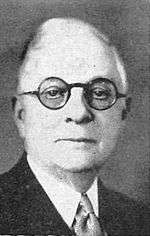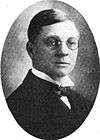Levi E. Young
| Levi E. Young | |
|---|---|
 | |
| First Council of the Seventy | |
| October 6, 1909 – December 13, 1963 | |
| Called by | Joseph F. Smith |
| Personal details | |
| Born |
Levi Edgar Young February 2, 1874 Salt Lake City, Utah Territory, United States |
| Died |
December 13, 1963 (aged 89) Salt Lake City, Utah, United States |
Levi Edgar Young (February 2, 1874 – December 13, 1963) was a general authority of The Church of Jesus Christ of Latter-day Saints (LDS Church). He was one of the seven presidents of the Seventy from 1909 until his death.

Young was born in Salt Lake City, Utah Territory, the son of LDS Church general authority Seymour B. Young and grandson of Joseph Young. Levi Young graduated from the University of Utah in 1895, and later became a faculty member at the same school, teaching history. Later in his life, he would do graduate studies at Harvard University and Columbia University and earned an M.A. and Ph.D. in history from Columbia.
From 1901 to 1904, Young served as a Mormon missionary in Germany, Austria, and Switzerland. For the last two years of his mission, he was the president of the Swiss–Austrian Mission of the church.
Of his life spent in both clerical and academic pursuits, J. Golden Kimball, in good humor, said of Young: "That little shrimp. He goes around here carrying water on both shoulders, and he's afraid to lean one way or the other for fear of spilling some of it."[1]
When George Reynolds died in 1909, Young was selected to take his place in the First Council of the Seventy. Young became the senior president of the Seventy in 1941 and continued in that position until his death. He died in Salt Lake City, Utah.
Young is also alleged to have been the source[2] from which the existence of the 1832 account of Joseph Smith's first vision, a major point of doctrine in the Mormon Church, came to light. While recounting an interview with Young after his death, LaMar Petersen, an amateur Mormon historian, mentioned that Young had recounted of a 'strange account' of the first vision that was kept, separate from its original book from which it had been excised, in the Church historian's office, Joseph Fielding Smith, who at the time of the recounting had ascended to the position President in the Mormon Church. Smith denied access to the original documents to Jerald and Sandra Tanner, a pair prominent of Mormon critics and historians but subsequently granted access to the original document to a BYU Paul R. Cheeseman to base he's dissertation on the account. With the introduction of The Joseph Smith Papers project, the original letter book confirms that the pages related to the account were later re-inserted into the book[3].
References
- ↑ L. Jackson, Newell, ed. (1996). Matters of Conscience: Conversations with Sterling M. McMurrin. Salt Lake City: Signature Books. p. 75. ISBN 1560850876.
- ↑ "The 1832 First Vision account was suppressed between 11 and ~30 years". Mormonbandwagon.com. 18 June 2016. Retrieved 8 October 2018.
- ↑ "Letterbook 1, Page 3". Josephsmithpapers.org. Retrieved 8 October 2018.
External links
- Grampa Bill's G.A. Pages: Levi E. Young
- Levi Edgar Young's diary from at L. Tom Perry Special Collections, Brigham Young University
- Levi Edgar Young Papers. MSS 561; 20th Century Western and Mormon Americana Manuscripts; L. Tom Perry Special Collections, Harold B. Lee Library, Brigham Young University.
- Levi Edgar Young Letter. MSS 3929; Levi Edgar Young letters; 20th Century Western and Mormon Manuscripts; L. Tom Perry Special Collections, Harold B. Lee Library, Brigham Young University.